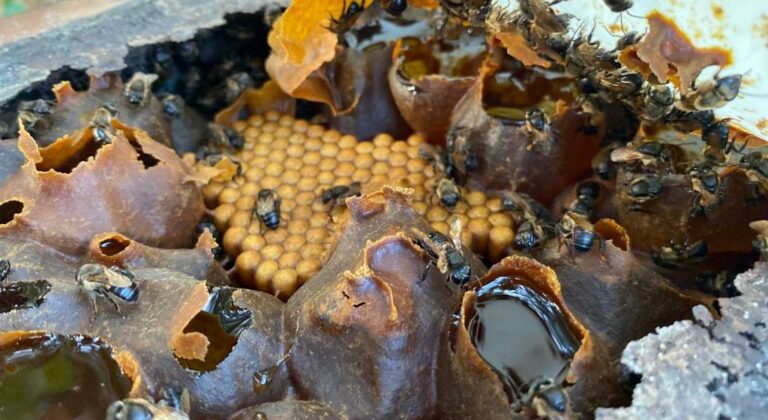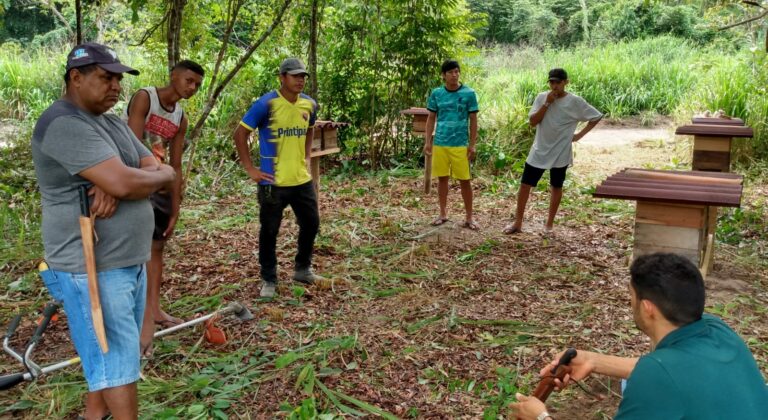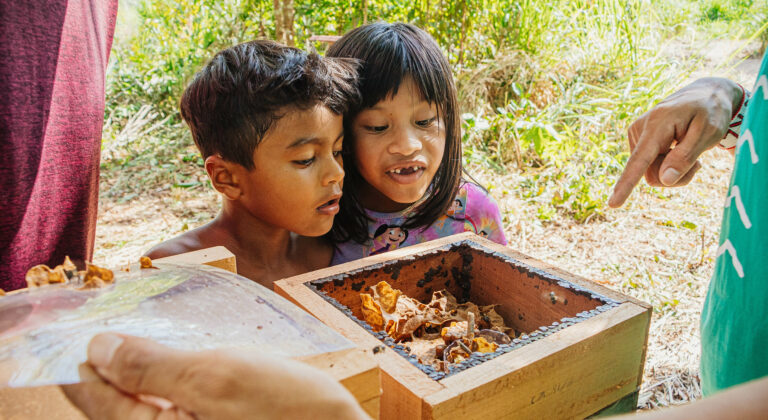Abelhas e Comunidades
Fortalecendo cuidadores de abelhas sem ferrão pelo mundo
Read in English
Com inspiração vinda do incrível mundo das abelhas sem ferrão, nativas das regiões tropicais e subtropicais em todo o mundo, a Meli tem orgulho de apresentar o programa “Abelhas e Comunidades”. Esta iniciativa única conecta diversas comunidades de origens indígenas, quilombolas, extrativistas e campesinos em escala global, promovendo seu engajamento coletivo em temas de extrema importância para a apicultura nativa.
Dentro deste programa, facilitamos uma vibrante troca de conhecimento e experiências, unindo culturas e tradições. Através de discussões interativas, insights compartilhados e iniciativas colaborativas, essas comunidades encontram pontos em comum em sua dedicação à preservação das abelhas sem ferrão e de seus ecossistemas vitais. Juntas, elas moldam um futuro harmonioso onde as práticas de apicultura nativa, conhecidas como meliponicultura, ocupam o centro do palco.
Ao fortalecer práticas de meliponicultura, “Abelhas e Comunidades” não apenas fortalece comunidades, mas também tem um profundo impacto positivo na biodiversidade local. Essas práticas promovem o equilíbrio ecológico, melhoram os serviços de polinização e contribuem para a conservação de espécies nativas de abelhas em perigo. Este programa é um testemunho do poder da união além das fronteiras e origens, capacitando comunidades a protegerem essas criaturas notáveis e a criarem um mundo mais sustentável e biodiverso.
Rede
Comunidades engajadas na Meli onde desenvolvem meliponicultura:
Sobre Abelhas:
Stingless bees are important pollinators and a highly diverse group of neotropical bees. In Brazil, for example, many species coexist ...
Stingless bees are a very diverse group of tropical bees, with some species similar in size to a fruit fly ...
An interdisciplinary event showcasing indigenous wisdom, academic research, and cutting-edge technology to conserve stingless bees and their habitats. The launch ...
Ever wondered what are the main differences between honeybees and stingless bees? Besides the colours and sizes, many characteristics are ...
Cacica Joana and meliponiculturist Orlando gave an emotional presentation of their village, Raízes da Ayahuasca, during the latest virtual meeting ...
Ana Paula Cipriano shares her experience of moving to the United Kingdom to start her PhD at the University of ...
The activities in the village of Campo de Perizes are already bearing fruit! The meliponary construction project in the community ...
Awareness on the importance of stingless bees to the environment has been inducing residents of Parauapebas/PA to become meliponicultors. Author: ...
Another project is coming to the Pollinating Regeneration program! The teachers Aruak and Yvoty wrote a project to strengthen the ...
The Bees and Culture project continues showcasing the tremendous strength of the Parkatejê community in the Mãe Maria Indigenous Land, ...
A recent study, led by Dr. Eduardo Almeida, a professor at the University of São Paulo, investigated the genetics of ...
In Brazil there are around 300 species of stingless bees and research with these pollinators is important so that we ...
The Pollinating Regeneration program has its first two ideas becoming reality: a project leading innovations based on indigenous wisdom. Authors: ...
Stingless bees are essential species for the preservation of the Amazon forest and a viable source of income for local ...
See how the project supported the local biodiversity, the community’s resilience, education and protection of cultural heritage, food sovereignty and ...
Native beekeeping (meliponiculture) motivates and fascinates us. It is beautiful to see the strength of a network of native beekeepers, ...












